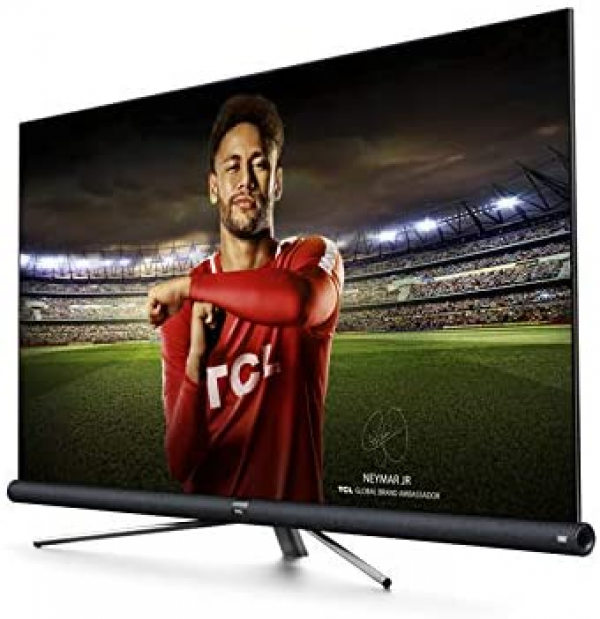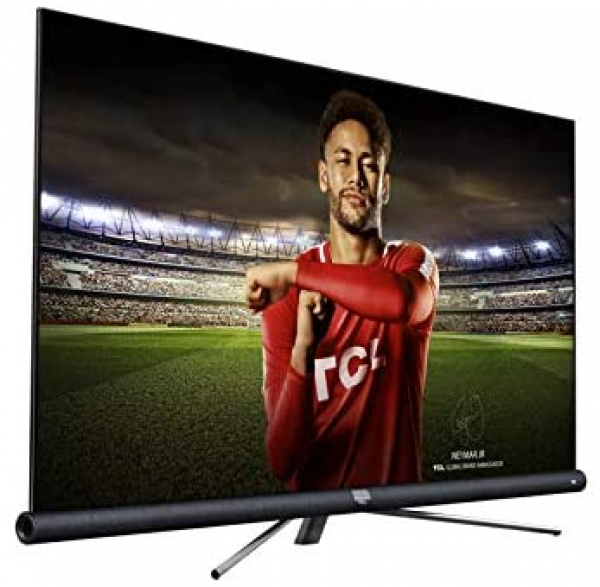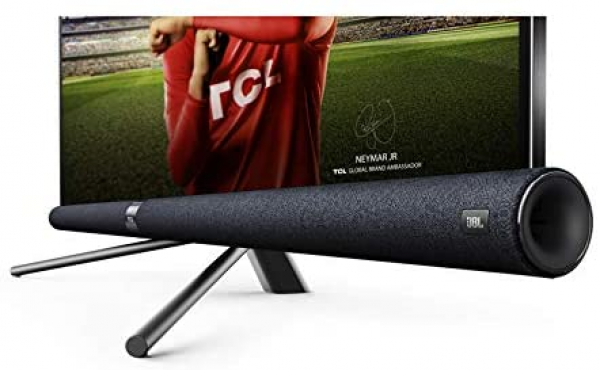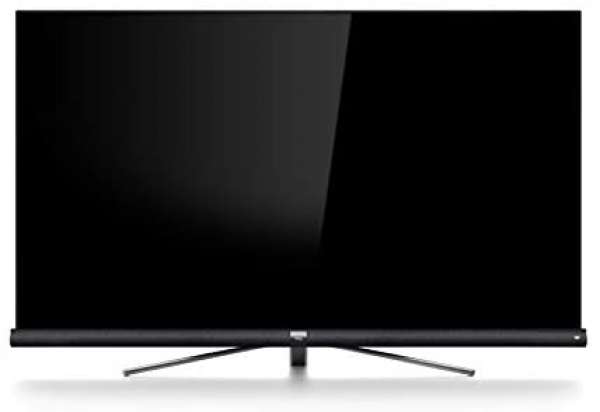TCL
TCL 55DC760: the Ultra HD television that wants to dominate the mid-range
Aprox. 717€
See specificationsThe TCL 55DC760 television is the successor to the famous TCL U55C7006 which surprised us with its very good price / quality ratio. Since Samsung came out of its torpor with its NU7105 range and the TCL 55DC760 therefore has a lot to do to establish itself as a reference on the mid-range.
Positive points
Image quality in the medium high.
Native contrast.
Possibilities offered by Android TV (become more stable).
Google Cast built-in.
Bad points
Maximum brightness which limits the interest of HDR.
Viewing angles.
No backlight on the remote control.
No passage for cables at the back.
Our review
Presentation
The TCL 55DC760 has a 10 bit VA (8 bit + FRC) LCD panel displaying an Ultra HD definition of 3,840 x 2,160 px. The panel is content with a refresh rate of 50 Hz and a brightness peak limited to 400 cd / m². This television succeeds the TCL U66C7006 and the Chinese manufacturer has completely revised the design of its flagship television. The TCL 55DC760 opts for a fairly aerial foot and above all a base of the tubular slab which suggests the integration of a sound bar. The audio part is also still signed JBL. On the system side, TCL embeds Android TV in its latest version 8.0 with its lot of features.
The TCL U55DC760 television, successor to the 55C7006, is sold for around € 900. It is also available in a 65-inch version for a price of around € 1,400.
All the brightness and colorimetric measurements mentioned in this article were carried out with a SpectraCal C6-HDR probe and the CalMAN Ultimate software.

Image quality
The TCL 55DC760 uses a VA panel which always offers more limited viewing angles than those of the IPS or Oled models. Despite everything, the loss of brightness at 45 ° is limited to 59% while some VA panels fall to 75%. On the other hand, the black is much less deep, since it goes from 0.04 cd / m² on the front to 0.23 cd / m² at 45 ° on the sides. This results in a washed-out image as soon as you move away from the axis a little.
In Film mode, colors cannot be considered as faithful. In fact, the average delta E is greater than 3, a threshold above which the human eye can perceive a difference between the colors displayed and the colors expected. There are many shades that exceed a Delta E of 4, but none exceed a Delta E of 5.5.
The gamma curve shows some stability over the whole spectrum. The average is 2.33 and only the light grays are slightly blocked at the start of the spectrum. The overall gamma rendering remains very satisfactory.
If the average temperature measured at 7,210 K deviates slightly from the 6,500 K sought (video standard), the curve is relatively stable over the entire spectrum. The rendering is therefore generally cold, but it is uniform.
LCD VA technology provides a good native contrast ratio, which here is 3,540: 1. This value allows you to enjoy fairly deep blacks, even in a dark room, but beware, you must stay in line with the TV.
TCL's scaling engine is very soft and does not allow gaining precision in the Full HD image. It just smooths out certain details, which generates solid visible effects. However, this process does not distort the original source and does not generate artifacts. A good point. The motion compensation system used by TCL is not very efficient and above all it generates rather annoying artifacts.

HDR
With a maximum HDR signal of 10,000 cd / m², the Display Tone Mapping used by TCL is quite good. It follows the reference curve while smoothing the signal from 60% to avoid the phenomenon of clipping. The problem comes from the peak brightness of 389 cd / m², too limited to be able to properly appreciate HDR content. This model is also compatible only HDR10 and HLG. It lacks compatibility with dynamic HDR technologies such as HDR10 + or Dolby Vision which precisely make up for this lack of brightness on entry-level and mid-range televisions. In comparison, the best LCD TVs, like the Samsung 65Q9FNAT or the Sony 65XF9005, exceed 1,000 cd / m², and the Samsung 75Q900R, the brightest on the market, even exceeds 2,000 cd / m².
We also measure color fidelity in HDR mode. We chose the HDR Film mode, which offers the best colorimetric rendering. The average delta E is measured at 3.2, which is slightly more faithful colors than in SDR mode, but a hue exceeds the threshold of 6. The colors displayed by this television set in HDR mode are therefore good overall. Too bad, once again, that the brightness peak spoils the HDR experience a bit.
The TCL 55DC760 is content with 64% of the Rec.2020 space and 85% of the DCI-P3 space. Color coverage is quite far from that of high-end models such as the Q9 or Oled TVs (which reach 75% of Rec. 2020 and more than 95% of DCI-P3), but this remains acceptable for cinema content, currently mostly mastered in DCI-P3.

Video games
With a remanence time of 15.5 ms, this television is located in the good average. It remains quite far from the best LCD TVs, like the Samsung 65Q9FN which goes down to 12 ms or the Sony 65XE9005 with its 11.5 ms. This results in a slight blurring effect behind moving objects. In terms of display delay, here again, the TCL is not at the level of Samsung models which drop below 15 ms, but the delay measured at 27.7 ms results in less than 2 images per second of delay relative to the source (at 60 Hz ). There is therefore very little lag between an action on the joystick and its repercussion on the screen. In practice, discomfort is caused when the input lag is greater than 60 ms.
We are now evaluating color fidelity with the mode that allows the best display delay. If the TCL television does offer a Game mode, the latter is not of much use since the Film mode already allows to have a reduced display delay while maintaining colors close to those of origin, which This is not the case in Game mode. We therefore advise you to simply play in Film mode.

Clouding
The TCL TV only has one backlight bar, located at the base of the panel. If we did not find a clouding problem on the model we tested, the risk is present, because the diffusion filter is fragile and can be damaged during transport. This results in the appearance of grayish spots on a uniform background. Finally, we did not notice any light leakage on our test model; on the other hand, vertical blooming is sometimes annoying, especially on the subtitles, and more generally on all light objects on a black background.
The average difference in uniformity of the white across the entire screen is measured at 10% - the eye detects nothing below 20%; that's a good number, especially for a 55-inch Edge Led LCD TV.
Ergonomics
The design of the TCL 55DC760 is quite original. The Chinese manufacturer tries to stand out from the competition with its airy foot and its sound bar - which is not one - clearly visible. This 55 inch TV is comfortable on our reference TV stand which measures 160 cm wide by 40 cm deep. Since the TCL U55C7006, the finishes have been improved and this TV seems overall better finished.
The reflectance index of the TCL 55DC760 is not flattering and the panel has trouble filtering out reflections. It is still doing better than the Samsung UE55NU7105, its direct competitor.
The TCL TV alone has a thickness of 9 cm on the lowest part. The size of the TV on the TV stand is always linked to that of the stand. The latter has a depth of 32 cm. High depth, especially for a 55 inch model. In comparison, some Oled models have a foot less than 25 cm deep (LG 55B8, Philips 55POS9002F, etc.). This television is therefore just at ease on this 40 cm deep piece of furniture.
The back of the TV is as understated as possible. The originality comes from the reinforcement bar on the upper part of the slab which reinforces the rigidity of the whole in order to avoid the phenomenon of clouding. On the left, we find the connection while the power is present on the right. There is no passage provided for the cables and it is therefore necessary to use trickery to make the cables disappear or group together.
The connection consists of three HDMI 2.0a inputs HDCP 2.2 and HDR compatible, two USB ports including a USB 3.0, an optical digital audio output, an Ethernet port, a PCMCIA port (Common Interface CI +), a headphone output, a composite input via the supplied adapter and the TNT, cable and satellite antenna sockets. This TV only has one DVB-T / T2 / C / S / S2 tuner. The TV also has Wi-Fi and Bluetooth.
The Android TV system is present in its latest version, 8.0. The layout of the home page has been revised to provide direct access to the content of the various applications. Google's Android system is still as complete and we find most of the flagship applications (Netflix, YouTube, Amazon Prime, Deezer, Spotify, etc.) and many others, such as video players (VLC, KODI, etc.). ). The interface is clear, but you can sometimes feel some slowdowns, especially if you have fun launching greedy applications. More interesting, the TV is compatible with Google Cast without having to buy a Chromecast.
As with all Android TVs, the first boot takes longer. It takes about 45 seconds here. It is much longer than Tizen systems from Samsung or WebOS from LG, which start up in less than 5 seconds. Fortunately, the TV comes out of standby in less than 5 seconds, while consuming less than one watt in standby. As often, the standby is instantaneous. Please note: to activate rapid recovery, you must activate the "Instant start" option in Android (Settings menu> Power) and not in the TV settings.
The TCL 55DC760 is delivered with two remote controls. The larger one is very pleasant to use. Light and long, it offers access to all of the functions and the main keys naturally fall under the thumb. The Netflix button has been brought to the bottom, which is a good thing to avoid handling errors. The rubber keys are nice and make almost no noise. The smaller remote is a little less comfortable to use. The buttons are made of hard plastic and the pressure noise is clearly audible. Its only advantage is the presence of a microphone greatly facilitating research. Neither has backlit buttons.
Audio
The TCL 55DC760 television has a sound bar that is not one, since it actually hides two small 15-watt speakers. The television delivers a correct sound, in the good average. It is not one of the best in the category, but for a mid-range model, it is doing with honors. The speakers provide a frequency response between 80 and 20,000 Hz at 79 dB (A), but you should not push the volume too high.
Consumption
We measured consumption at 55 W on our target with a white set at 150 cd / m², which translates into a relative consumption of only 66 W / m². This value is lower than the average of the TVs tested (around 100 W / m²), but this TCL does not do any better than the Sony KD-65XE8505, record-holder of the category with its 56 W / m² or the Samsung QE65Q9FNAT and its 61 W / m². Standby consumption is always less than 1 W.
Conclusion
If last year the TCL U55C7006 TV surprised us with its quality, this is not the case with this TCL 55DC760. It is no longer enough to deliver a well-calibrated image to stand out on the market for mid-range Ultra HD televisions, all the more so since Samsung has woken up and now offers well-calibrated models (Samsung UE55NU7105) at sometimes very attractive prices.
Specifications

